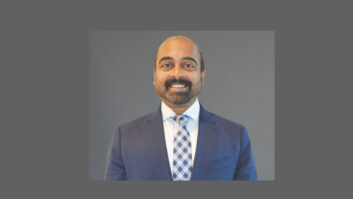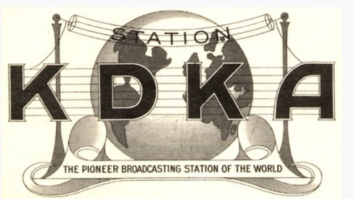
The late Larry Estlack, shown in a Facebook page in his memory. Search “Friends of Larry Allen Estlack.” It’s not often a filing to the FCC is dedicated to someone who’s passed away. Comments about AM revitalization from the Broadcast Warning Working Group honored the late Larry Estlack, one of its members and the director of technology for the Michigan Association of Broadcasters.
BWWG is all about EAS, so it has an interest in AM. You probably know most if not all of its members: Adrienne Abbott,chair of the EAS Nevada State Emergency Communications Committee; Clay Freinwald, chair of the EAS Washington State committee; Suzanne Goucher, president/CEO of the MaineAssociation of Broadcasters; Barry Mishkind, the veteran engineer and industry journalist; David Ostmo of the Sinclair Broadcast Group in San Antonio, Texas; and Richard Rudman, vice chair of the EAS California SECC.
They write that AM is “an invaluable national resource” but that the band needs a “resurrection” and not just revitalization. They noted that EAS was enhanced when some AMs became part of the Primary Entry Point system in 1997 and that recent hurricanes demonstrate what can happen when communications are slammed and officials need a reliable way to talk to the public. AM’s simplicity and reliability are assets then. But what to do?
‘UNIQUE BUT DEVASTATING’
Transmitter power increases aren’t the answer; they “will eventually be negated by the still rising tide of RF noise in the band,” BWWG writes. Nor will digital transmission will overcome this. “Masking of power line-radiated noise is only effective until the noise rises to a level where Bit Error Rates exceed their ability to function and the digital signal vanishes.”
The group reiterated what many have been saying: The noise floor has increased sharply, stealing signals and audiences. It pleaded with the FCC to enforce Part 15 rules and support delivery alternatives other than broadband over power lines.
The high-voltage power grid infrastructure generates its own “unique but devastating” noises, a problem that seems to be getting worse. Further, new high-tension lines near directional transmitters act as long-wire antennas that “broadcast” harmonic noise; BWWG says we should hold utilities accountable.
Further, station over-modulation causes “splatter” to adjacent channels; older transmitters and poor processing practices can mean problems 20 kHz away. The group thinks the FCC should reduce negative peak modulation to 96 percent for AM and clarify wording in Part 73 on this topic.
“We should allow a 4–5% margin for error for settings, power supply issues and measurement errors. This will provide a better spectral median strip between broadcasters vying for what most audio experts believe is a race for a mythical audience bent on searching for the loudest signals on the band. … It is time for the commission to end the destructive AM modulation race that some broadcasters continue to pursue, despite solid technical data that such a race has no basis in reality.”
The group throws up its hands on the topic of devices that make noise like computers, switching power supplies, compact fluorescent lights and fish tank thermostats; it says Part 15 controls are not effective, but: “We have no answers, only questions about why these sources are still allowed to contribute to the damage being done to the AM band.”
The BWWG is (relatively) restrained about HD Radio but thinks “it may be time for an honest and rigorous revisiting of IBOC for AM to see if turning it off can help revitalize this troubled band by giving amplitude modulation signals ‘breathing room.’” It also cites bandwidth standards adopted by some broadcasters that reduce analog audio fidelity as well as “compromise advantages” that favor digital but hurt coverage of adjacent-channel stations. Blending and noise floor problems exacerbate the digital situation.
RECEIVER STANDARDS
The group’s comments are well worth reading. (I’ve saved them for you at http://bit.ly/1mGcAzF.)
They further want to see receiver standards that mandate or encourage use of synchronous AM detection or other detection methods that can help stave off electrical noise. “The commission regulates standards for receivers in other services. Why not do this as a key component for AM band resurrection?”
Dramatically, BWWG suggests that Congress should not allow manufacturers to market FM-only receivers, even in cars. It feels that Congress could do this as part of a national public warning strategy, treating AM as a national emergency resource.
If FM translators are part of AM revitalization, BWWG continues, tie each to an AM station and specify that the license is non-transferrable. Allow installation of translators at AM transmitter sites; and make it clear that a translator can only be on the air if the AM is on the air, except for night operation by daytimers.
It says the FCC should not apply the “ratchet rule” in certain cases, to avoid unintended consequences. (For more on this, see radioworld.com/ratchet.) The group further asks that the FCC require stations to certify that reports for tests as described in Section 73.44 have been carried out at least once a year. And they suggest making better use of the band above 1610 kHz: “Directional array AM (DA) stations literally running in ‘sardine can’ or narrow local AM channel conditions should be given preference in the expanded band, as well as for other options that will allow for power and coverage increases.”
The FCC should explore making different use of 530 kHz, too. Should the frequency be allocated to bring back “clearer channel” stations that could bring AM coverage, “especially for major emergencies,” to areas where service is missing?
Daytime stations would be permitted Pre-Sunrise Authority at 500 watts, Post-Sunset Authority at 500 W at least until 6 p.m. Protection coverage for Class A stations would be reduced, to help AMs that are running “at or near financial failure an opportunity to serve a wider audience.” Further, AMs should be allowed to use any antenna/transmitter, with no minimum efficiency, basically as long as annual NRSC measurements show compliance; but BWWG wants the FCC to stiffen and enforce rules against stations running more than 10 percent over.
It also suggests an upgrade preference for licensees that promise to maintain emergency power generation and other “resilience measures” and that commit in writing to devote resources to emergency public information as needed.
The group concludes by saying no ideas filed with the FCC will produce a total cure for the AM patient. “Full recovery will require aftercare by responsible licensees offering quality local programming and public service that really matters to the public, and to the overall public safety emergency communications picture.”
I think the Broadcast Warning Working Group offers great ideas here, though I’m dubious about the chances (and advisability) of a government mandate. Usually the market knows best.
What do you think? Comment below. To see more opinions about AM, visit radioworld.com/amcomments.To read an obituary of the late Larry Estlack, go to our website and enter keyword Estlack.












